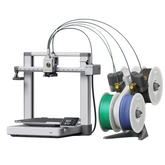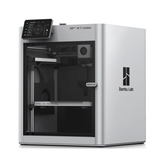Top 5 Bambu Labs Printer Compared
Summary
Bambu Lab is a consumer technology company that specializes in desktop 3D printers, which was founded in 2020 by a team of engineers who previously worked at the well-known drone manufacturing company DJI.
Right then, let's not spend forever on this. You can stare at specifications sheets on Bambu Lab's website for days trying to figure out which printer is right for you. Instead, how about we break it down to the practical benefits? What do the differences actually mean for the prints you get and the things you can do?
In this blog, we're cutting through the noise to compare five key printers in the Bambu Lab lineup: the A1, the P1S, the X1-Carbon, the X1E, and the brand-new H2D.

Overview of Bambu Labs
Bambu Lab was founded in China by 4 engineers, with Dr. Ye Tao as the main engineer who previously worked at DJI experimenting with DIY 3D printers. The company's team consists of experts in robotics, artificial intelligence, materials science, and internet industries, all united by their passion for 3D printing machine. Their mission focuses on making cutting-edge technology affordable while maintaining high production quality and pushing toward eco-friendly 3D printing solutions.
The company has quickly become a significant player in the 3D printing industry, with operations spanning three locations: Shenzhen and Shanghai in China, and Austin, Texas in the United States.
Top 5 Bambu Labs Printers
Now that you’ve an idea about 3d printers, let’s not waste any more time and get into the comparisons. Starting with the Bambu Lab A1
The Starting Point: Bambu Lab A1

The Bambu Lab A1 3d printer is your most valuable starting point. It has the same 256mm³ build volume as the more expensive P-series and X-series printers, but it's a "bed slinger." This means the build plate moves back and forth, so you'll need a bit more desk space behind it. Because of this, it might be a tiny bit less stable on hyper-speed prints than the other models, but the difference is marginal.
The main thing to know is this: the A1 is fantastic for basic materials like PLA filament, PETG, and TPU. If that's all you'll ever need, the A1 is probably your best choice. The one catch is its multi-color system, the AMS Lite. It leaves your filament spools out in the open, where they can absorb moisture and degrade print quality. For casual use, it's fine. For serious, multi-material work, you'll want to step up.
Features:
- It has a 256 x 256 x 256 mm build volume, which makes it a versatile desktop printing option for most projects.
- The 3d printer offers fully automatic bed leveling and flow calibration, ensuring easy setup and reliable prints every time.
- With the AMS Lite system, users can enjoy basic multi-color printing with up to four different filaments.
- The A1 operates quietly, thanks to active motor noise cancellation, making it suitable for home and classroom environments.
- It features a quick-swap nozzle system, allowing for fast and tool-free maintenance and nozzle changes.
The Workhorse for Everyone: Bambu Lab P1S

Now we get to the CoreXY models. Let's take the P1S 3d printer as our primary comparator. This is an enclosed printer that looks and feels like a professional product. The enclosure is the key here. Why does it matter? It keeps the internal temperature stable, which is absolutely critical for printing stronger plastics like ABS and ASA. Just walking past an open-frame printer can create a draft that ruins an ABS print. The P1S solves that problem.
You might be asking, "Do I even need to print those materials?" If you have to ask, the answer is probably no. But if you want to keep your options open for the future, the P1S is the perfect sweet spot. It also uses the fully enclosed AMS unit, which protects your filament from moisture with desiccant packs—a huge benefit.
Features
- The CoreXY motion system enables high-speed and stable printing, ideal for both simple and complex models.
- Its fully enclosed chamber maintains a stable temperature, making it reliable for printing ABS, ASA, and other temperature-sensitive materials.
- The P1S is compatible with the standard AMS, which protects filament from moisture and supports multi-material printing.
- An activated carbon filter is included to reduce odors and airborne particles during printing.
- The printer features automatic bed leveling and filament runout detection for a hassle-free experience.
The Prosumer Flagship: Bambu Lab X1-Carbon

The X1-Carbon 3d printer is the flagship, and it’s built for engineering-grade materials. It comes standard with a hardened steel nozzle designed for abrasive filaments like carbon fiber reinforced plastics. If you need parts that are incredibly strong and rigid, this is where you need to be.
But the X1C also has quality-of-life features that might make it the more considered option. It has a much more powerful onboard computer. This means its camera feed is a smooth, 1080p live stream, not the stuttery 720p feed of the P1S. You can also wirelessly download files from the SD card. The biggest difference is the Lidar. While some call it a gimmick, it actively scans the first layer for defects and has saved me from failed prints many times. It's a safety net for when you click print and walk away.
Features
- The X1-Carbon comes with a hardened steel nozzle, making it perfect for printing with abrasive filaments like carbon fiber composites.
- It uses a Lidar sensor for first-layer inspection and flow calibration, ensuring precision and reducing print failures.
- AI-powered spaghetti failure detection and print monitoring provide added peace of mind during long prints.
- The high-speed CoreXY system allows for rapid acceleration up to 20,000 mm/s², delivering fast and accurate results.
- Users benefit from a smooth 1080p camera feed and wireless file management for convenient remote monitoring.
The Secure Professional: Bambu Lab X1E

Think of the X1E 3d printer as the X1-Carbon's enterprise-grade twin. It's designed for businesses, schools, and engineering firms where security and high-performance materials are non-negotiable. It adds two critical features: an Ethernet port for secure, off-cloud operation, and active chamber heating.
That heated chamber lets you reliably print industrial-grade materials like PPA-CF and PPS, which require extreme temperature stability. It also has a more robust filtration system. If you're working in a professional environment or with truly demanding engineering filaments, the X1E is built specifically for that purpose.
Features
- The X1E features active chamber heating up to 60°C, enabling reliable printing with industrial-grade materials.
- Enhanced air filtration is provided through a G3 pre-filter, HEPA filter, and carbon filter, ensuring a safer working environment.
- It includes an Ethernet port and Wi-Fi kill switch, making it suitable for secure enterprise and educational settings.
- The printer supports advanced engineering filaments such as PPA-CF, PPS, and PPS-CF for specialized applications.
- Its AI-powered monitoring and Lidar technology ensure consistent print quality and reliability.
The Future of Making: Bambu Lab H2D

The H2D is an entirely different beast. It's not just a 3D printer machine; it's a multi-tool fabrication system. It has the largest build volume of the lineup and a dual-nozzle extrusion system for complex prints. But its main selling point is its interchangeable tool head. You can swap out the extruder for a 10W or 40W laser cutter and engraver, a digital vinyl cutter, or a pen plotter.
This is for the innovator who needs more than just a 3D printer. It consolidates an entire workshop's worth of tools into one machine. If your projects involve cutting, engraving, and drawing in addition to printing, the H2D is the all-in-one solution.
Features:
- The H2D offers the largest build volume in the lineup, up to 350 x 320 x 325 mm, accommodating larger and more ambitious projects.
- It features a dual-nozzle extrusion system, allowing for complex and multi-material prints with ease.
- The interchangeable tool head supports not only 3D printing but also laser cutting, vinyl cutting, and pen plotting, making it a true multi-tool fabrication system.
- A heated chamber is included for high-speed, high-performance fabrication with demanding materials.
- The H2D is compatible with the AMS 2 Pro, which enables advanced multi-material printing and integrated filament drying for optimal results.
Comparison of the Top 5 Bambu Labs 3D Printer
So, which one is right for you? Hopefully, this table will help make it easier for you to compare the 5 models.
| Feature | A1 | P1S | X1-Carbon | X1E | H2D |
|---|---|---|---|---|---|
| Ideal User | Beginners | Hobbyists | Professionals & Prosumers | Enterprise & Engineering | Innovators & Small Businesses |
| Build Volume | 256 x 256 x 256 mm³ | 256 x 256 x 256 mm³ | 256 x 256 x 256 mm³ | 256 x 256 x 256 mm³ | Up to 350 x 320 x 325 mm³ |
| Motion System | Bed Slinger | CoreXY | CoreXY | CoreXY | CoreXY |
| Enclosure | Open-Frame | Fully Enclosed | Enclosed (Aluminum & Glass) | Fully Enclosed | Fully Enclosed |
| Max Nozzle Temp | 300°C | 300°C | 300°C | 320°C | High-Temperature (TBA) |
| Chamber Heating | No | No (Passive) | No (Passive) | Yes, Active (60°C) | Yes, Heated |
| Nozzle Material | Stainless Steel | Stainless Steel | Hardened Steel | Hardened Steel | Dual-Nozzle Extrusion |
| Advanced Sensors | Flow Dynamics Calibration | Automatic Bed Leveling | Micro Lidar & AI Detection | Micro Lidar & AI Detection | Advanced (TBA) |
| Air Filtration | None | Activated Carbon | Activated Carbon | G3 Pre-filter + HEPA + Carbon | Advanced (TBA) |
| AMS Compatibility | AMS lite | AMS (Standard) | AMS (Standard) | AMS (Standard) | AMS 2 Pro |
| Multi-Tool Head | No | No | No | No | Yes (Laser/Cutting/Plotting) |
| Connectivity | Wi-Fi, Bambu-Bus | Wi-Fi, MicroSD | Wi-Fi, MicroSD | Ethernet, Wi-Fi w/ Kill Switch | Advanced (TBA) |
| Key Feature | Low-cost & user-friendly | Enclosed workhorse value | Prints abrasive composites | Secure & high-temp printing | Versatile fabrication system |
Conclusion
Choosing the right Bambu Lab printer boils down to one thing. What are your specific needs? Whether you're just getting started and researching how to build a 3D printer, or you're ready to invest in a high-performance machine, Bambu Lab has you covered. From the beginner-friendly A1 to the professional X1E and the versatile H2D, there is a perfect fit for every user and ambition. We hope this comparison has made your decision easier. Ready to start creating? Explore the complete Bambu Lab lineup, available in India right here at Robocraze.













